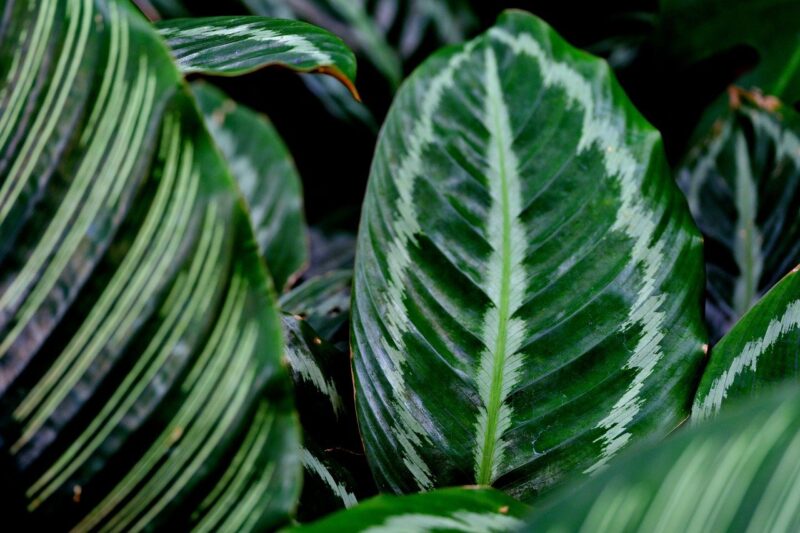Here’s a closer look at some of the most captivating large tropical plants that you can introduce to your space.
Elephant Ear Plant (Colocasia)

The Elephant Ear Plant, often found in tropical regions, is known for its massive, heart-shaped leaves that can grow up to three feet long. Native to Southeast Asia and equatorial Africa, this plant requires a warm, humid environment to thrive. It can be grown both indoors and outdoors, though it’s best placed in shaded areas to protect it from scorching sun. With its impressive size and unique leaf shape, the Elephant Ear makes an excellent focal point in any garden design. Its foliage not only adds visual interest but also creates a lush, jungle-like ambiance that can transport you to distant shores.
Bird of Paradise (Strelitzia)

Renowned for its striking appearance, the Bird of Paradise, or Strelitzia, is named for its vibrant and oddly-shaped flowers that resemble a bird in flight. Hailing from South Africa, this plant thrives in sunny environments and can reach heights of 6 to 7 feet. Its large, paddle-shaped leaves can also grow quite large, contributing to an overall tropical aesthetic. In addition to their beauty, Bird of Paradise plants require minimal care, making them a favorite among gardeners and plant enthusiasts alike. Over time, these plants can become a showpiece in garden spaces, bringing bursts of color and life.
Umbrella Plant (Schefflera arboricola)
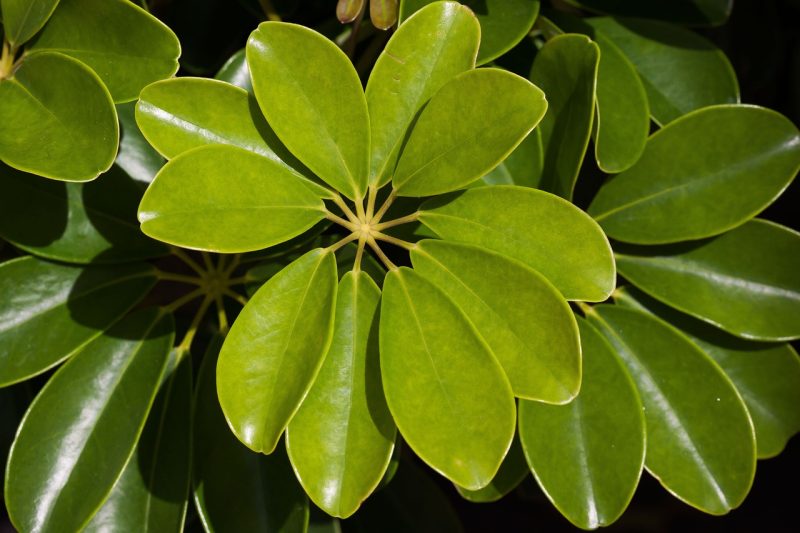
The Umbrella Plant is celebrated for its unique leaf arrangement, resembling an umbrella’s spokes. Often used as a houseplant, it can also thrive outdoors in warmer climates. This plant is resilient and adaptable, typically growing up to 3 to 4 feet tall when cultivated indoors, and can achieve greater heights in the outdoors. Its glossy, palmate leaves are not only attractive but act as air purifiers, making it a great choice for homes. The Umbrella Plant is perfect for those looking to add an element of greenery without the heavy maintenance demands.
Fiddle Leaf Fig (Ficus lyrata)
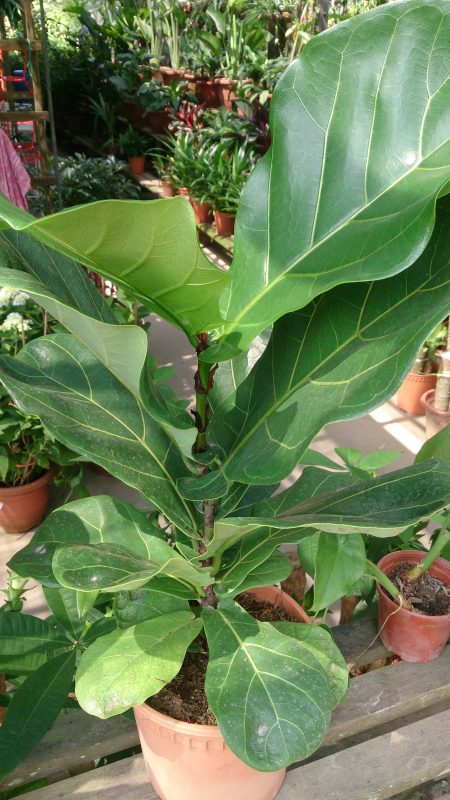
The Fiddle Leaf Fig has surged in popularity in recent years, captivating the hearts of decorators and plant lovers alike. With its large, bow-shaped leaves and robust structure, this tree can grow to impressive heights, making it an eye-catching addition to any room. Native to West Africa, it flourishes in bright, indirect light and requires routine watering to keep its soil consistently moist. The Fiddle Leaf Fig serves not only as decor and a conversation starter but also as a symbol of botanical elegance in modern spaces.
Canna Lily (Canna indica)

Canna Lilies, admired for their vibrant, tropical blooms, are a standout among large tropical plants. They can reach heights of 3 to 6 feet, offering colorful flowers in hues of red, orange, and yellow. These plants thrive in full sun and require rich, well-draining soil to flourish. Their lush green foliage adds a tropical flair to gardens, while the blooms attract hummingbirds and butterflies, enhancing the outdoor experience. The versatility of Canna Lilies makes them a perfect choice for borders, containers, or as a statement piece in larger garden layouts.
Monstera Deliciosa

Monstera Deliciosa, often known as the Swiss Cheese Plant, is celebrated for its eye-catching foliage, featuring natural holes and splits that create a distinct look. This climbing plant can reach heights of 10 feet indoors, making it a dramatic addition to any space. Originating from the rainforests of Central America, Monstera thrives in bright, indirect light and benefits from high humidity levels. Its leaves can grow extremely large, providing a striking backdrop in any room while also improving air quality.
Jungle Velvet Calathea (Calathea warscewiczii)

With its unique leaf patterns and stunning velvety texture, the Jungle Velvet Calathea is a true gem among large tropical plants. Known for its rich, dark green leaves adorned with striking light green veins, this plant prefers indirect light conditions and a humid environment to keep its foliage vibrant. Reaching heights of up to 2 to 3 feet, it adds not only a luxurious aesthetic but also brings a sense of calm to any indoor setting. Calathea is often considered a pet-friendly plant, making it a great choice for families who want to maintain a lush environment without worrying about toxicity.
Philodendron Xanadu

The Philodendron Xanadu is a popular choice for tropical landscaping and indoor gardening due to its distinctive, lobed leaves and bushy growth habit. This plant can grow to around 3 feet tall and spreads about 3 to 4 feet wide, creating a dense, lush appearance that can thrive in both direct and indirect light. What sets the Xanadu apart is its ability to tolerate varied conditions, making it an excellent low-maintenance option for those looking to embrace lush greenery. The glossy leaves not only contribute to a healthy ambiance but also help filter air pollutants, enhancing indoor air quality. This plant is particularly well-suited to brighten up corners or serve as a centerpiece in larger spaces, making it a versatile addition to both home décor and office environments.
Croton Plants (Codiaeum variegatum)

Croton plants are celebrated for their vibrantly colored leaves, which display a striking array of hues including greens, yellows, oranges, and purples. With their bushy growth and sometimes towering heights that can exceed 6 feet, Crotons can create a remarkable visual impact in any setting. These tropical beauties thrive best in full sunlight and prefer warm, humid conditions, making them a delightful addition to gardens or sunlit patios. Their bright foliage not only attracts attention but also adds an uplifting atmosphere, ideal for tropical landscaping or as colorful, vivid houseplants.
Rubber Tree (Ficus elastica)
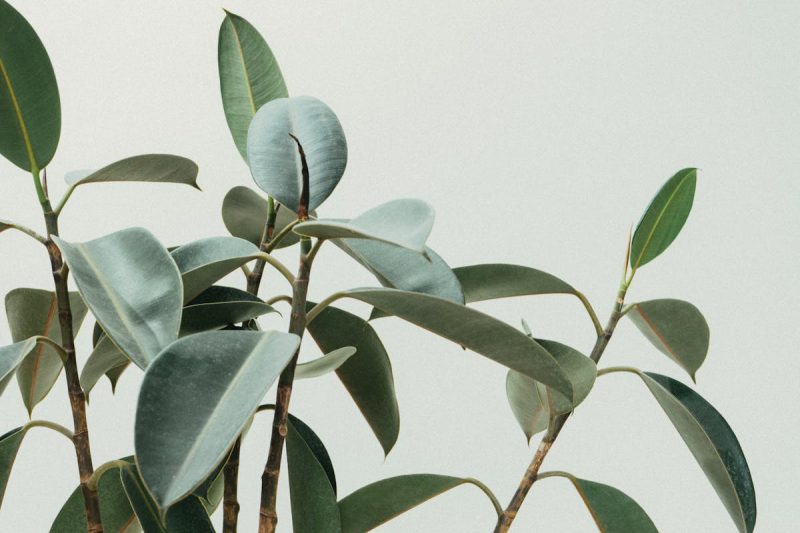
The Rubber Tree is known for its lush, dark green leaves and impressive height, often reaching up to 8 feet when grown indoors. Originating from Southeast Asia, this hardy plant can adapt to various indoor conditions but thrives best in bright, indirect light. Its thick leaves are not only aesthetically pleasing but also help improve air quality by filtering toxins from the air. The Rubber Tree’s striking silhouette and expansive foliage create a dramatic focal point in rooms, making it a favorite among interior designers looking to incorporate elements of nature into their designs.
Persian Shield (Strobilanthes dyerianus)

The Persian Shield is a stunning tropical plant recognized for its iridescent purple and silver leaves, making it a standout in any collection. Growing to about 3 feet tall, it showcases a striking color palette that shifts as the light changes, creating a dynamic visual effect. Native to Myanmar, this plant thrives in partial shade and prefers moist, well-draining soil. Its unique coloration makes it an excellent choice for mixed plant borders or as an eye-catching complement to other tropical plants. Moreover, it offers versatility, thriving in pots, gardens, and indoor arrangements alike.
African Mask Plant (Alocasia amazonica)

The African Mask Plant, or Alocasia amazonica, features striking arrowhead-shaped leaves with distinctive white vein patterns. This eloquent plant can grow up to 2 to 3 feet tall and is known for its dramatic appearance and striking foliage. Preferring bright, indirect light and high humidity, the African Mask Plant thrives in warm environments. Its unique leaf shape and vibrant color ensure it catches the eye, making it a beautiful addition to tropical gardens or indoor plant displays. Additionally, this plant serves as a conversation starter due to its exotic roots and striking presence.
Red Aglaonema

The Red Aglaonema, known for its lush, deep green leaves speckled with vibrant red and pink hues, is a versatile and hardy tropical plant. This species enjoys low to medium light conditions, making it an ideal houseplant for spaces that don’t receive direct sunlight. Its bushy, compact growth habit can typically reach about 2 feet tall, allowing it to fit comfortably into various interior spaces. In addition to its striking aesthetics, the Red Aglaonema is also recognized for its air-purifying capabilities, thus enhancing indoor air quality while contributing to a stylish décor.
Philodendron Gloriosum

The Philodendron Gloriosum is a stunning plant distinguished by its large, heart-shaped leaves that can grow over a foot wide. Known for its velvety texture and beautiful deep green color, this tropical beauty thrives in a warm, humid environment, making it suitable for indoor collection or as part of outdoor gardens in suitable climates. As a climbing plant, it can be trained to grow on trellises or poles, enhancing its visual interest as it matures. The Philodendron Gloriosum’s unique foliage and ability to adapt to various care conditions make it a popular choice for plant enthusiasts seeking something a bit different.
Heliconia Plants
Heliconia plants are renowned for their striking, lobster-claw flowers that come in vivid shades of red, orange, and yellow. These large tropical plants can reach heights of up to 10 feet and are predominantly found in tropical areas of Central and South America. They thrive in humid, tropical environments and prefer partial to full sun exposure. Heliconia not only serves as an eye-catching feature in tropical gardens but also attracts hummingbirds and pollinators, fostering a lively ecosystem. Their dramatic appearance and unique flowers make them an exceptional choice for gardeners seeking to create a lush, vibrant landscape.
Banana Tree Plant (Musa)

The Banana Tree (Musa) is not just a source for delicious fruit but also a striking ornamental plant known for its dramatic foliage. With large, paddle-like leaves that can grow up to 10 feet tall, the Banana Tree introduces a bold tropical vibe to any garden or indoor space. Originating from Southeast Asia, these plants thrive in warm, humid environments and enjoy plenty of sunlight. Aside from their aesthetic appeal, Banana Trees are relatively easy to care for, requiring regular watering and well-draining soil. When cultivated in the right conditions, they can produce clusters of bananas, adding both beauty and bounty to your space.
Peacock Plant (Calathea makoyana)

The Peacock Plant, or Calathea makoyana, is well-known for its stunning leaf patterns that resemble the beautiful plumage of a peacock. This tabletop tropical plant features oval leaves with rich green tones accented by dark green and light green markings. Preferring humidity and indirect light, the Peacock Plant makes an exquisite addition to indoor spaces. It grows to around 1 to 2 feet tall, making it suitable for various indoor displays, from tabletops to hanging arrangements. Its striking foliage and unique leaf movement, which raises and lowers with the day, add a dynamic element to any plant collection, making it a favorite among plant lovers.
Calathea Orbifolia

The Calathea Orbifolia is admired for its broad, round leaves that feature bold, green and silver stripes. This low-growing tropical plant reaches heights of around 1 to 3 feet and loves humidity, making it well-suited for bathrooms or kitchens. The circular shape and vibrant markings of the leaves create an eye-catching display that adds a touch of elegance to any space. Calathea Orbifolia thrives in indirect light and requires consistently moist soil to flourish, making it a unique choice for plant enthusiasts wanting to create a lush indoor environment.
Tropic Snow Dumb Cane (Dieffenbachia seguine)
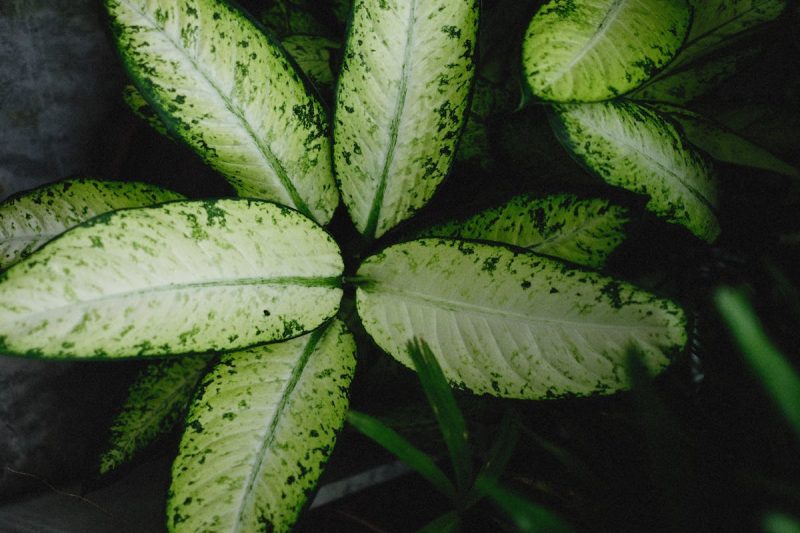
The Tropic Snow Dumb Cane is a popular ornamental plant recognized for its thick, variegated leaves that blend shades of green and cream. This robust plant can also grow tall, often reaching heights of 4 to 6 feet, which makes it a splendid choice for filling up empty corners in rooms. While it prefers bright, indirect light, it can tolerate lower light conditions as well. However, care should be taken, as the sap can be toxic if ingested. Nonetheless, this plant is cherished for its dramatic foliage, adding a tropical touch while requiring relatively low maintenance.
Ruffled Fan Palm (Licuala grandis)

The Ruffled Fan Palm is a stunning specimen that boasts unique, pleated fronds shaped like fans, making it an exceptional tropical accent. This palm grows in clusters and can reach heights of up to 6 feet indoors, often showcasing its beautiful, ruffled leaves. Native to the tropical rainforests of Southeast Asia, the Ruffled Fan Palm thrives in partial to full shade, making it suitable for indoor environments or shaded gardens. It requires regular watering to maintain its humidity and thrives in rich, well-draining soil. The elegant shape of its fronds elevates any area, from homes to public gardens.
Colorful Ti Plants (Cordyline fruticosa)

Colorful Ti Plants are distinguished by their vibrant, multicolored foliage, ranging from deep green to striking pink, red, and purple. Native to tropical regions of Southeast Asia and the Pacific Islands, they can reach heights of 3 to 10 feet, making a dramatic statement in any landscape or indoor setup. Thriving in full sun to partial shade, Ti plants are relatively low maintenance, requiring periodic watering and well-draining soil. Their colorful appearance not only enhances visual interest but also symbolizes good fortune and prosperity in various cultures, which is why they are often used in landscaping and decorative arrangements.
Tropical Bromeliad Houseplant (Bromeliaceae)

Bromeliads are a diverse group of tropical plants known for their stunning flowers and unique rosette forms. These houseplants can vary in size and color and often boast bright, eye-catching blooms. Many Bromeliads are epiphytic, meaning they thrive by attaching to other plants, making them adaptable to various living conditions. Preferring bright, filtered light, these plants require minimal watering, as their leaves can capture water during rain. A Bromeliad can add a vibrant pop of color and unique texture to indoor plant collections or tropical gardens, making them a delightful choice for both novice and experienced plant enthusiasts.
Caladium

Caladiums are tropical plants known for their beautiful, heart-shaped leaves that come in striking color combinations of green, pink, red, and white. These plants are often grown for their foliage, which can be quite dramatic, making them perfect for adding a splash of color to shaded corners of gardens or as eye-catching indoor accents. Caladiums thrive in well-drained, nutrient-rich soil and prefer partial to full shade. They are often planted as summer annuals in temperate climates or can be grown as houseplants year-round in suitable conditions. Their captivating foliage makes them a popular choice for ornamental gardens and indoor displays.
Calathea Medallion
The Calathea Medallion, also known as Calathea veitchiana, is revered for its striking leaves, which feature a rich green background adorned with silvery oval patterns. This compact tropical plant grows to about 1 to 2 feet tall and enjoys high humidity and indirect light, thriving in moisture-rich environments. Known for its stunning aesthetic appeal, the Calathea Medallion also exhibits a unique quirk—its leaves will open in the morning to receive sunlight and close at night, creating a lively and dynamic display. This plant is perfect for indoor spaces, where its decorative foliage can brighten up any room.
Lady Palm

The Lady Palm (Rhapis excelsa) is a popular indoor palm known for its graceful, fan-shaped fronds that can grow up to 5 feet tall. Lady Palms are highly adaptable and can thrive in a variety of light conditions, from low light to bright indirect sunlight. They do well in well-drained, rich soil and require regular watering to keep the soil consistently moist. The Lady Palm is favored for its elegant appearance and its ability to improve indoor air quality, making it a great choice for homes and offices alike.
Cast Iron Plant (Aspidistra elatior)

The Cast Iron Plant is renowned for its toughness and ability to thrive in challenging environments, making it a perfect choice for those new to indoor gardening. This hardy perennial features long, arching, dark green leaves that can reach about 2 feet in length. The Cast Iron Plant can tolerate low light, neglect, and irregular watering, though it prefers indirect light and evenly moist soil for optimal growth. Its durability and low maintenance requirements make it a popular choice for offices and homes, where it can add a touch of greenery without much fuss.
Corn Plant (Dracaena fragrans)

The Corn Plant, or Dracaena fragrans, gets its name from its tall, corn-like leaves that grow in a rosette formation. This popular houseplant can reach heights of up to 6 feet indoors and is prized for its dramatic, arching foliage that varies in color from deep green to yellow-green variegation. Corn Plants thrive in bright, indirect light but can adapt to lower light conditions, making them versatile for home environments. They require moderate watering, allowing the top layer of soil to dry between watering sessions. With its elegant stature and air-purifying qualities, the Corn Plant is a fantastic choice for both aesthetics and health in indoor spaces.



